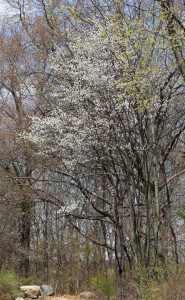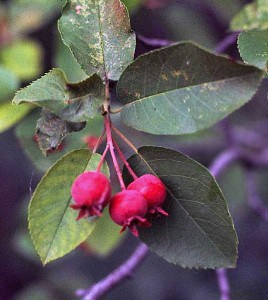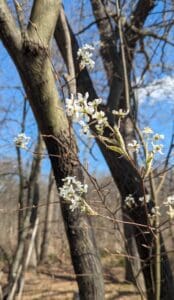

(Chelsea Update would like to thank Tom Hodgson and the Waterloo Natural History Association for the information and photos in this column.)
While driving by the largely leafless woodlands this time of year, one may occasionally see a splash of white blossoms. They are born by a small shrubby tree that goes by many names including serviceberry, Juneberry, or shadbush. All are appropriate and in some way descriptive.
When buying a cultivated variety, however, one should ask for Amelanchier, its genus name.
There are many stories involved with the name serviceberry. Some say in early times the opening of serviceberry blossoms was an indication that all frost is out of the ground and those unfortunate souls who died over the winter months could now be given a proper burial and an appropriate “service” could be held.
Another happier story says that those born in winter were baptized in the spring once the frost was out of the ground and travelling preachers could once again hold services.
Still another says that the blossoming usually coincides with Easter services. Regardless of the truth behind any of those stories, the name persists.

The story behind Juneberry is more obvious, as its fruits normally ripen in June. The term shadbush is primarily an east coast moniker, as blossoming there coincides with the running of the shad, an anadromous fish (related to trout and salmon) that leaves the Atlantic Ocean each spring to spawn in local streams and rivers.
This week, Amelanchier is in full bloom at the Discovery Center and throughout the Waterloo Recreation Area. The blossoming period is short, however, and by next week they will be history for another year.
Although the blossoms are short-lived, we can still look forward to the fruit which ripens in June. When fully ripe they are a deep red to purple and are similar in texture to blueberries, but with a rather bland flavor. They are, however, quite edible and nutritious, and were a summer favorite of Native Americans.
Their turning leaves contribute bright orange and red colors to the fall season, especially some of the cultivated varieties. Their blossoms are always welcome in spring, and their berries attract colorful birds in summer including such stunners as scarlet tanagers and Baltimore orioles. Its relatively small size also makes it an ideal landscaping plant. So regardless of what it is called, this is a plant of many virtues.
















Tom –
Thank you for another great article. I learn so much from them and they add to my enjoyment on woodland walks. Today we walked from Portage Lake to Sackrider. The service berries were blooming all along the trail – right along with spring beauty, white trillium, bloodroot and many other wildflowers.
Lovely May day
Nancy